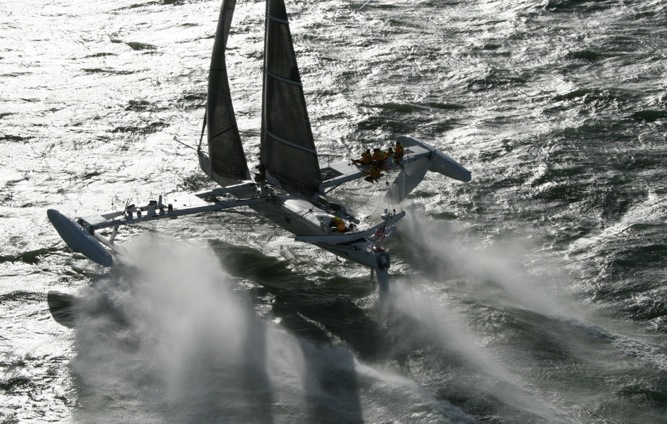

Everyone wants to be FASTEST….
The prospect of sailing fastest has tantalised many - including us.
Lots of attempts have been made to break Yellow Pages Endeavour's 1993 world record of 46.52 knots.
It would be 12 years before Finian Maynard achieved 48.70 knots - on a sailboard!
It would be 12 years before Finian Maynard achieved 48.70 knots - on a sailboard!
In March 2008, Antoine ALBEAU lifted the outright world speed record to 49.09 knots.
However, after 10 years, 50 knots/ 57 mph/ 93 km/hr is still a dream.
Sailing technology is ready for a breakthrough.
What are the factors that limit the speed of conventional sailing craft?
In all 'conventional' craft there is a tipping moment that is produced by the driving and keel reaction forces.
In particular, the wind-generated driving forces which may be visualised as acting part-way up the mainsail, are opposed by keel reaction forces acting just below the waterline.
The effect of this moment is to tip the craft leeward or, in a following breeze, cause it to pitch-pole.
The effect of this moment is to tip the craft leeward or, in a following breeze, cause it to pitch-pole.
All measures used to oppose or 'balance' this moment have a negative impact on speed.
For example:
1. Adding ballast increases weight > increases the wetted area > greater drag.
2. Using body weight or multi hulls to balance the wind force works OK to the point of instability - which determines the ultimate speed.
1. Adding ballast increases weight > increases the wetted area > greater drag.
2. Using body weight or multi hulls to balance the wind force works OK to the point of instability - which determines the ultimate speed.
It is as if the laws of physics have conspired to limit the speed of wind-driven craft to less than 50 knots - until now...
___________________________________________
Left: On 5 March 2008 Antoine ALBEAU set the current outright world speed record of 49.09 knots in Les Saintes Maries de la Mer, France on a custom Neil Pryde Sailboard.
Below: Another serious contender is Hydroptére which has achieved >47 knots

Yellow Pages Endeavour achieved 46.52 knots in 1993.
Sails on one tack only and so has limited real-world relevance
Sails on one tack only and so has limited real-world relevance


